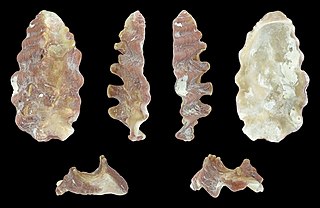
The Lesser Antilles are a group of islands in the Caribbean Sea. Most of them are part of a long, partially volcanic island arc between the Greater Antilles to the north-west and the continent of South America. The islands of the Lesser Antilles form the eastern boundary of the Caribbean Sea where it meets the Atlantic Ocean. Together, the Lesser Antilles and the Greater Antilles make up the Antilles. The Lesser and Greater Antilles, together with the Lucayan Archipelago, are collectively known as the West Indies.

The West Indies are a subregion of North America, surrounded by the North Atlantic Ocean and the Caribbean Sea that includes 13 independent island countries and 18 dependencies and other territories in three major archipelagos: the Greater Antilles, the Lesser Antilles, and the Lucayan Archipelago.
Nuculana acuta, or the pointed nut clam, is a marine bivalve mollusc in the family Nuculanidae. It can be found along the Atlantic coast of North America, ranging from Massachusetts to Texas, including the West Indies.

Arca imbricata, or the mossy ark clam, is a clam in the family Arcidae. It can be found along the Atlantic coast of North America, ranging from North Carolina to the West Indies, Brazil, and Bermuda.

Barbatia candida, or the white-bearded ark clam, is a clam in the family Arcidae. It can be found along the Atlantic coast of North America, ranging from North Carolina to Texas, including the West Indies.

Anadara transversa, or the transverse ark clam, is a clam in the family Arcidae. It can be found along the Atlantic coast of North America, ranging from Massachusetts to Texas, including the West Indies.

Glycymeris undata, or the Atlantic bittersweet, is a species of bivalve mollusc in the family Glycymerididae. It can be found along the Atlantic coast of North America, ranging from North Carolina to the West Indies and Brazil.
Musculus lateralis, common name the lateral mussel, is a small species of bivalve mollusc in the family Mytilidae. It can be found along the Atlantic coast of North America, ranging from North Carolina to the West Indies and Brazil.

Botula fusca, or the cinnamon mussel, is a species of bivalve mollusc in the family Mytilidae. It can be found along the Atlantic coast of North America, ranging from North Carolina to the West Indies and Bermuda.
Lithophaga nigra, or the black date mussel, is a species of bivalve mollusc in the family Mytilidae. It can be found along the Atlantic coast of North America, ranging from southern Florida to the West Indies.

Atrina serrata, or saw-toothed pen shell, is a species of bivalve mollusc in the family Pinnidae. It can be found along the Atlantic coast of North America, ranging from North Carolina to Texas and the West Indies.

Plicatula gibbosa, or the Atlantic kitten's paw, is a species of bivalve mollusc in the family Plicatulidae. It can be found along the Atlantic coast of North America, ranging from North Carolina to the West Indies.

Dendostrea frons, the frond oyster, is a species of bivalve mollusc in the family Ostreidae.
Ostrea permollis, the sponge oyster, is a species of bivalve mollusc in the family Ostreidae. It can be found along the Atlantic Coast of North America, ranging from North Carolina to the West Indies.
Diplodonta punctata, or the Atlantic diplodon, is a species of bivalve mollusc in the family Ungulinidae. It can be found along the Atlantic coast of North America, ranging from North Carolina to the West Indies and Bermuda.

Chama macerophylla, or the leafy jewel box clam, is a species of bivalve mollusc in the family Chamidae. It can be found along the Atlantic coast of North America, ranging from North Carolina to the West Indies.
Dallocardia muricata, the yellow cockle, is a species of bivalve mollusc in the family Cardiidae. It can be found along the Atlantic coast of North America, ranging from North Carolina to the West Indies and Brazil.
Americardia media, the Atlantic strawberry cockle, is a species of saltwater clam, a marine bivalve mollusc in the family Cardiidae, the cockles. This species can be found along the Atlantic coast of North America, from Cape Hatteras to the West Indies.
Globivenus rigida, or the rigid Venus clam, is a species of bivalve mollusc in the family Veneridae. It can be found along the Atlantic coast of North America, ranging from southern Florida to the West Indies and Brazil.

West Indiaman was a general name for any merchantman sailing ship making runs from the Old World to the West Indies and the east coast of the Americas. These ships were generally strong ocean-going ships capable of handling storms in the Atlantic Ocean. The term was used to refer to vessels belonging to the Danish, Dutch, English, and French West India companies.











